A European approach to financing the EU’s new industrial policy

For decades, industrial policy was sidelined in the EU. But in recent years, multiple crises and geopolitical rivalries have brought it back to the table. The challenges are enormous: the climate crisis requires the first guided energy transition in history. The Covid-19 crisis has highlighted significant external economic dependencies created by globalisation. Finally, the growing rivalry between the United States and China has revealed the limits of a rules-based global economic order, putting major pressure on the competitiveness of European industries in the struggle for technological dominance.
Gradually, European elites have become aware of the need for and usefulness of a more active industrial policy. With the pandemic and the recent energy price crisis, EU Member States have agreed on a series of temporary state aid frameworks to support affected industries and accelerate the green transition on the basis of national subsidies. With the PIIECs (‘projects of common European interest’), the EU has also developed a more collaborative instrument to restore European technological leadership. Nevertheless, in recent years, state aid has been based mainly on national funding. This approach risks fragmenting the EU’s single market, a key resource for European influence in the geopolitical rivalries that are currently intensifying.
Although there is now a growing consensus on the need for a more European industrial policy, there is no equivalent consensus on how to finance it. However, pressure to develop a truly European industrial policy will continue to mount with the expiry of the temporary State aid frameworks in 2025 and the end of the European recovery plan a year later. Today, the EU and its Member States should move from a temporary, ad hoc approach to a permanent, strategic approach based on a common industrial policy fund. This fund should finance projects across the EU, in line with European interests and objectives, focusing on the most innovative projects.
To respond immediately to the risks of fragmentation of the single market and global competition, the EU industrial policy fund should receive a significant initial endowment, based on new European debt and/or European taxes. Subsequently, the fund should be self-financing on the basis of two different sources of revenue. First, a contribution to the common fund should be requested from all Member States that rely primarily on national state aid. This would make European funding more attractive while leaving room for manoeuvre for national industrial policies. Secondly, profit-sharing mechanisms should be required for all projects benefiting from state aid. Taken as a whole, this proposal could help build a compromise between Member States that are enthusiastic and sceptical about a more active industrial policy and ensure that the benefits and risks of such an approach are shared fairly between the public and private sectors.




